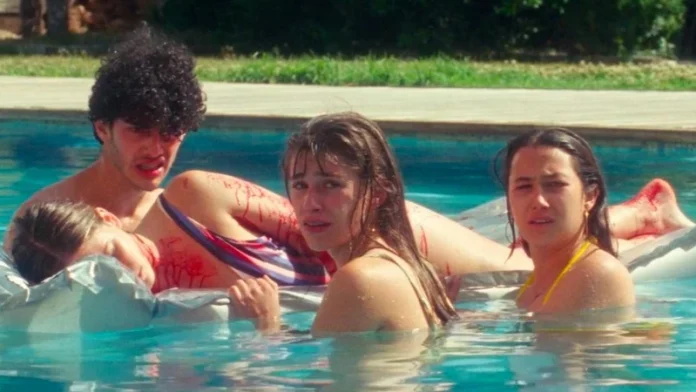Spanish cinematographer Ion de Sosa—known for his work with Lois Patiño on Ariel and with Chema García Ibarra on The Sacred Spirit, one of the standout films of Locarno 2021—has also directed works such as Mamántula (2023). This year, he brought Balearic to Switzerland, premiering in the Cineasti del presente (Filmmakers of the Present) section—a hazy, allegorical vision of the world we live in and the path we’re heading down. Themes of class segregation, privilege, and indifference drift through the film, alongside a youth handed a broken planet and a society already rigged with pre-established hierarchies, all conveyed through two separate stories that subtly intersect between the lines—and quite openly by the end.
In the first segment, on an unnamed island where we never see the sea, a group of young people break into a mansion. While two of the girls explore the completely empty interior, a couple stays outside, arguing about their relationship. Eventually, the four reunite and, in the midst of total isolation with no one else in sight, decide to use the swimming pool. It’s at this moment that they’re violently attacked by dogs, —the scene abruptly cuts to the film’s second narrative.
A few kilometers away, the wealthy gather at a lavish villa for St. John’s Eve. They sip drinks, chat about superficial topics, and the setting exudes a conventional, upper-class ambiance.. Cocktails are poured, conversations revolve around trivialities, and everything exudes a traditional, conservative form. Yet they avoid entering the pool itself, gripped by a ritual unease. They ignore everything—like people in an ivory tower, convinced they’ve earned their comfort and thus owe nothing beyond their own self-interest. A forest fire looms in the distance, but they relegate it to the background, carrying on as if untouched, as if immune to the world’s suffering.
In the spirit of The Exterminating Angel (1962) by Luis Buñuel, Mama Turns 100 (1979) by Bigas Luna, and Triangle of Sadness (2022) by Ruben Östlund—but with a heightened, intellectualized aesthetic of social horror conveyed through Cris Neira’s grainy, sun-drenched 16mm cinematography (in Cinemascape, echoing Sergio Leone)—the film feels like it could easily belong on Shudder if it were American.
Xenia’s pulsating techno soundtrack, paired with gory moments (the dog attack) and scenes of unmistakable discomfort, makes Balearic thoroughly symbolic. Whether through an enclosed elite sheltered in comfort while the world burns outside, or through a group of youth seeking respite in spaces of privilege only to be attacked by the challenges of modernity, the film functions as a potent allegory.
The result is an unsettling portrayal of tension beneath a sunlit paradise—one that, as Davi Pretto described in Futuro Futuro, constantly evokes an unnamed evil present in the atmosphere.


